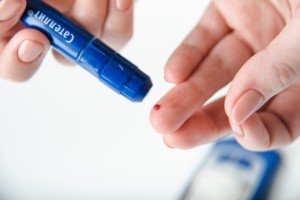Some “diabetes hypochondriacs” test their blood sugar repeatedly with home tests, wondering what really is the right reading range right after eating.
“It is not uncommon to have a one to two hour postprandial blood glucose level anywhere between approximately 70 and 145 mg/deciliter,” says Richard Kelley, MD, a practicing physician in Texas for 20+ years, and author of “The Fitness Response,” “The Three-Hour Appetite” and the ebook, “The Fitness Response ‘Diet’ for Women.”
Dr. Kelley explains, “The blood glucose range after eating can be markedly variable, depending on the lack or preponderance of carbohydrate in a given meal.
“Depending on the glycemic index of a particular food or carbohydrate, the blood glucose levels will vary greatly.
“For instance, if an individual eats a funnel cake from the fair, this is likely to result in a much quicker and possibly higher rise in blood glucose level, right after eating, than if the same individual consumed a plate of baked turkey and steamed broccoli.”
If you’re a hypochondriac about insulin resistance or type II diabetes and have a habit of frequently taking blood glucose readings, there are ways to dramatically reduce your chances of ever developing impaired glucose metabolism.
- In addition to restricting processed foods, go all-out at avoiding white-flour based foods as much as possible
- never consume more than 60 grams of carbohydrate in one sitting
- always have protein with carbs
- take 30 minutes to drink any tall glasses of juice (place glass in freezer for 30 minutes to create juice-ice so that it stays cold for 30 minutes once you start sipping)
- consume most of your carbohydrates either right after a workout and/or for breakfast
- and take the following supplements: omega 3 fish oil, turmeric, green tea, chromium picolinate and magnesium.
Add strenuous exercise and better sleep habits to your life, and it will be highly unlikely you’ll ever develop impaired glucose metabolism, so make an effort to stop fretting about your blood sugar readings.


 Richard Kelley, MD,
Richard Kelley, MD,






































